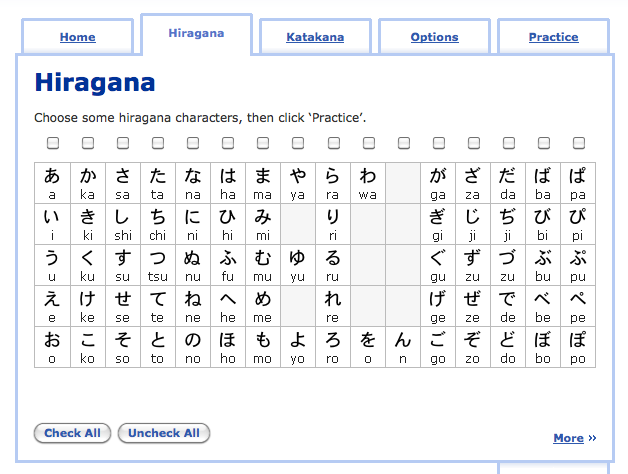You can not learn Japanese if you do not learn the 2 basic Japanese alphabets: Hiragana and Katagana. Or, at least, to learn the sounds that exist in the language. The Japanese alphabet does not contain letters but, instead, contains characters and, technically, they are not alphabets but character sets.
- What do you know about japanese numbers ?
- 2 basic alphabets in Japanese
- Do you know how to thank you in japanese ?
1. Japanese Hiragana alphabet
The characters in the chart below are called Hiragana. Hiragana alphabet is the main alphabet or character set for Japanese. Japanese also consists of two other character sets - Kanji (Chinese characters), which we will get into later, and another alphabet/character set, Katakana, which is mainly used for foreign words. Katakana will be covered later in this post. Don't wait to move on until you have all Hiragana characters memorized - learn them as you continue to go through the other lessons.
- Japanese hiragana alphabet
There are 46 basic Hiragana letters and 5 vowels(similar to English). (a), pronounced "ahh", (i), pronounced like "e" in "eat", (u), pronounced like "oo" in "soon", (e), pronounced like "e" in "elk", and (o), pronounced "oh". All Hiragana characters end with one of these vowels, with the exception of (n). The only "consonant" that does not resemble that of English is the Japanese "r". It is slightly "rolled" as if it were a combination of a "d", "r", and "l".
Exceptions:
1. The Hiragana は (ha) is pronounced "wa" when it immediately follows the topic of the sentence. This character is usually only pronounced "ha" when it is part of a word.
2. The Hiragana へ (he) is pronounced "e" when it immediately follows a place or direction. Both of these are very simple to detect.
As you see, the letter with symbol like “quotation marks” in the right of top such as が(ga),ば( ba), だ(da) are little variantly pronounced as letter which not attach “quotation mark” ( かka、は ha,たta。。。)。And that is obeyed fixed rule, change from “t” to “d”, “h” to “ b “, “k” to “ g” .
1. The Hiragana は (ha) is pronounced "wa" when it immediately follows the topic of the sentence. This character is usually only pronounced "ha" when it is part of a word.
2. The Hiragana へ (he) is pronounced "e" when it immediately follows a place or direction. Both of these are very simple to detect.
As you see, the letter with symbol like “quotation marks” in the right of top such as が(ga),ば( ba), だ(da) are little variantly pronounced as letter which not attach “quotation mark” ( かka、は ha,たta。。。)。And that is obeyed fixed rule, change from “t” to “d”, “h” to “ b “, “k” to “ g” .
2. Japanese Katagana anphabet
- Japanese katagana alphabet
The katagana alphabet is pronounced similar to hiragana alphabet but has different symbol .As mentioned, Katakana is mainly used for foreign words such as foreign names and words that have been borrowed from other languages such as コンピューター (kompyu-ta- = computer). Katakana is the least frequently used of the three character sets in Japanese (include japanese kanji alphabet, which will mentioned in another post ) . The Japanese language does not have as many sounds as the English language so, when creating a name in Katakana, for instance, the name must be sound out to the closest Japanese equivalent. Katakana, Hiragana, and Furigana (when Hiragana is written small next to a Kanji character to show how that character is read) are collectively known as Kana. Don't worry too much about Katakana (beyond maybe learning your name) for now.
There are some special Katakana characters that exist only for foreign names (such as シェ (she) or ティ (ti)). There are also the characters ヰ (wi) and ヱ (we) which were deemed obsolete in 1946.
Here some example about foreign name with katagana. It is so unique and strange when transliterate foreign names into Japanese kanji letter, but so exciting, right ?
Alex アレックス arekkusu
Alexander アレキサンダー arekisanda-
Andrea アンドレア andorea
Andrea アンドレア andorea
Andrew アンドリュー andoryu-
After learning this alphabet, you can write your name by Katagana and able to introduce yourself to Japanese. Learning is a process need to be patient and diligent. Learn alphabet in the true way will help you learn japanese easier and faster.
Source: blog.akirademy.com


Không có nhận xét nào:
Đăng nhận xét